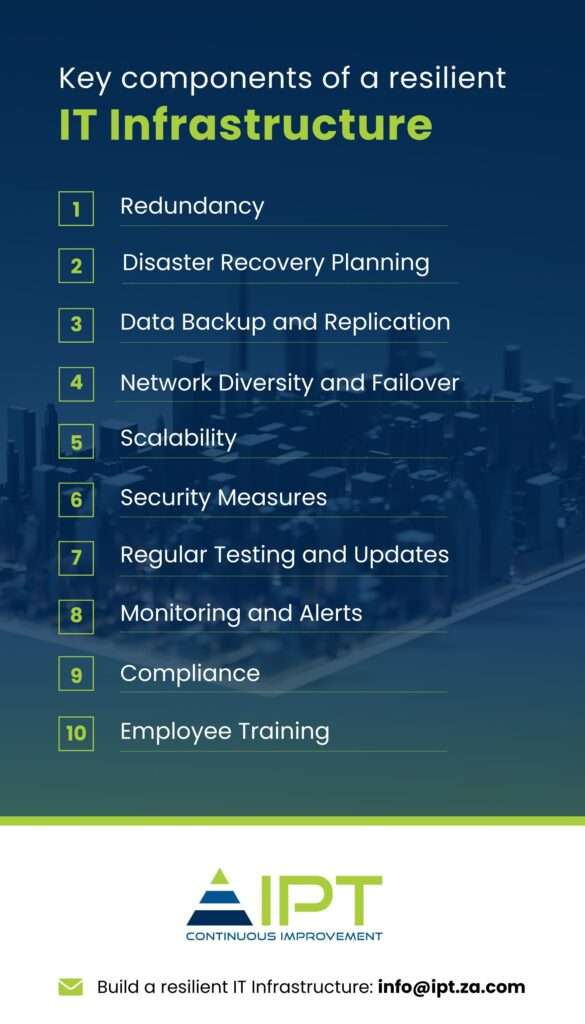
Build Your Business’s Backbone: Key Components of an IT Infrastructure
The stakes have never been higher for a resilient IT infrastructure. With an IT infrastructure forming the technological foundation of your business, you can’t afford to cut corners and compromise your operations.
This article breaks down the pivotal components of IT infrastructure and shares what you need to know to transform your IT landscape into a resilient, agile, and secure asset that not only supports but accelerates your business objectives.
1. Redundancy: Ensuring Continuity in IT Operations
Redundancy is a critical component of an IT infrastructure, acting as a failsafe against system failures. It involves creating duplicate systems, such as servers and databases, to ensure continuous operations in case one system fails. This approach is vital in sectors like e-commerce, where system downtime directly impacts revenue and customer satisfaction.
Key strategies:
- Invest in duplicate IT hardware to ensure critical components have back-ups.
- Geographically diversify data centres to protect against location-based disruptions.
- Implement load balancing to distribute workloads, optimising system performance.
2. Disaster Recovery Planning: Strategic Response to IT Emergencies
Disaster recovery planning is an organised approach to responding to and recovering from IT incidents. A comprehensive plan outlines procedures for various disaster scenarios, emphasising minimising downtime and data loss. This is crucial for businesses handling sensitive information, where data integrity and availability are paramount.
Recommended measures:
- Develop a detailed recovery plan to cover various disaster scenarios.
- Run regular training and drills to prepare your team for efficient disaster response.
- Conduct continuous plan updates to reflect changes in technology and your organisational structure.
3. Data Backup and Replication: Safeguarding Critical Information
Data backup is fundamental in preventing data loss. Thus, it’s a non-negotiable component of an IT infrastructure. Regular backups and maintaining replicated copies of data ensure business continuity, especially in sectors like finance and healthcare, where data accuracy and availability are critical.
Implementation tips:
- Ensure consistent data backup with automated backup schedules.
- Verify the reliability and effectiveness of backups with regular backup testing.
- Enhance flexibility and reliability with cloud-based solutions for data replication.
4. Network Diversity and Failover: Maintaining Seamless Connectivity
Network diversity and failover mechanisms are crucial for uninterrupted connectivity. By utilising multiple Internet Service Providers (ISPs) and automated failover systems, businesses can maintain operations even during network disruptions. This is especially important for organisations relying on continuous online presence, like digital marketing agencies.
Best practices:
- Diverse ISP engagement to reduce dependency on a single provider.
- Leverage automated failover systems to minimise downtime during network failures.
- Perform ongoing network performance reviews to ensure optimal operation and adjustments.
5. Scalability: Adapting to Changing Business Demands
Scalability in IT infrastructure is about adapting to your fluctuating business needs. Cloud-based solutions are particularly effective, offering you the flexibility to scale resources in response to varying demands, a crucial aspect for businesses experiencing seasonal traffic variations.
In fact, Gartner predicts that by 2027, more than 50% of enterprises will use industry cloud platforms to accelerate their business initiatives.
Scaling strategies:
- Utilise cloud services for scalability, allowing you to adjust resources according to demand.
- Monitor and analyse performance metrics to identify when scaling is necessary.
- Prepare for known peak periods, so you can anticipate and plan for increased demand.
6. Security Measures: Protecting Against Cyber Threats
Robust security measures are an essential component of an IT infrastructure if you wish to ensure protection from cyber threats. This includes implementing firewalls, encryption and conducting regular security audits. Effective security is particularly important for organisations handling large volumes of sensitive data, ensuring data confidentiality and integrity.
Security enhancements:
- Run regular updates and security audits to stay ahead of potential vulnerabilities.
- Conduct employee training to raise awareness about cyber security best practices.
- Perform routine penetration testing to assess the robustness of your security measures.
7. Regular Testing and Updates: Ensuring Optimal IT Performance
Regular testing and updating of IT systems are imperative for your company’s operational excellence. This practice ensures that systems are not only secure but also function efficiently. Keeping up-to-date with the latest software and security patches is especially crucial in safeguarding against emerging cyber threats.
Maintenance protocols:
- Plan for minimal operational impact by scheduling maintenance and updates.
- Validate updates before full deployment by testing in controlled environments.
- Ensure timely application of critical updates with automated patch management.
8. Monitoring and Alerts: Proactive IT Management
Continuous monitoring and effective alert systems are key in early detection and response to IT issues. These systems enable your organisation to respond swiftly to potential disruptions, essential in high-stakes environments where real-time data processing is critical.
Monitoring strategies:
- Invest in advanced monitoring tools to gain real-time insights into IT performance.
- Utilise effective alert systems, so you can ensure timely responses to detected anomalies.
- Maintain effectiveness and relevance with regular reviews of your monitoring parameters.
9. Compliance with Standards and Regulations: Upholding Industry Best Practices
Adherence to industry standards and regulations is a crucial component of an IT infrastructure. Compliance with regulations like GDPR or POPIA demonstrates a commitment to data security and privacy, essential for building client trust and maintaining professional integrity.
Compliance measures:
- Stay informed and compliant by keeping up with regular updates on relevant regulations.
- Conduct frequent compliance audits to ensure ongoing adherence to standards.
- Engage in continuous employee training to promote a culture of compliance.
10. Employee Training and Awareness: Fostering a Culture of IT Resilience
Employee training and awareness are vital in reinforcing the overall resilience of IT infrastructure. Regular training sessions on security best practices, phishing awareness, and proper data handling procedures empower employees to contribute to a secure and efficient IT environment.
Training initiatives:
- Keep staff informed and prepared with cyber security workshops.
- Encourage proactive security behaviours with a security-conscious culture.
- Simulate potential security incidents to test and improve your staff’s response strategies.
Dispelling Dangerous Myths About IT Infrastructure
When examining the components of an IT infrastructure, navigating between facts and fiction is pivotal for safeguarding digital assets and ensuring operational efficiency. Misconceptions about IT systems can lead to vulnerabilities and a false sense of security, to name a few.
Read on for commonly held but erroneous beliefs that can compromise the integrity and performance of your IT infrastructures.
More Technology Equals Better Security
It’s a common assumption that simply adding more technological tools and solutions will automatically enhance your organisation’s security. However, this assumption can lead to a complex and disjointed security environment, potentially creating more gaps than it fills. Effective security relies on the strategic integration of tools, combined with effective processes and ongoing employee training.
Relying Solely on Perimeter Defence
The reliance on perimeter defences such as firewalls, while ignoring internal security measures, overlooks critical threats like internal breaches and insider attacks. A comprehensive security strategy should incorporate multiple layers of defence, including both external and internal monitoring systems and stringent data access controls.
Set-and-Forget IT Infrastructure
There’s a dangerous assumption that once IT infrastructure is set up, it requires little to no maintenance. This mindset can lead to outdated systems, unpatched vulnerabilities, and inefficient operations. Regular maintenance, updates, and active monitoring are key to ensuring the ongoing health and security of IT systems.
Size Matters in Cyber Security
Many believe that small or medium-sized businesses are not typical targets for cyber-attacks due to their size. However, these businesses can be perceived as having lower defence mechanisms, making them attractive targets to attackers. Businesses of all sizes need to invest in robust cyber security measures.
Cloud Storage is Inherently Secure
While cloud service providers usually offer strong security measures, it’s a misconception that cloud storage is automatically secure. Security in the cloud is a shared responsibility; users must actively manage and secure their own data within the cloud environment.
Latest Technology Equates to Best Infrastructure
Some organisations mistakenly believe that the latest technology guarantees the most effective IT infrastructure. However, the true measure of effectiveness lies in how well technology is integrated, managed, and aligned with the organisation’s unique needs and goals.
Complete Outsourcing Negates Internal IT Expertise
Outsourcing IT management does not eliminate the need for internal expertise. In-house knowledge is crucial for strategic decision-making, aligning IT operations with your business objectives, and effectively managing outsourced IT functions.
Building and maintaining a resilient IT infrastructure is an ongoing journey that requires vigilance, adaptation, and continuous learning. Ultimately, you want to create a digital environment for your business that not only withstands the challenges of today but is also prepared for the uncertainties of tomorrow – a difficult but not impossible task.
At IPT, we provide the tools, expertise, and support to help you build and maintain components of an IT infrastructure. Whether you’re expanding, upgrading, or starting from scratch, we are ready to help.
Partner with us for a strong and agile IT foundation. Contact us today.

